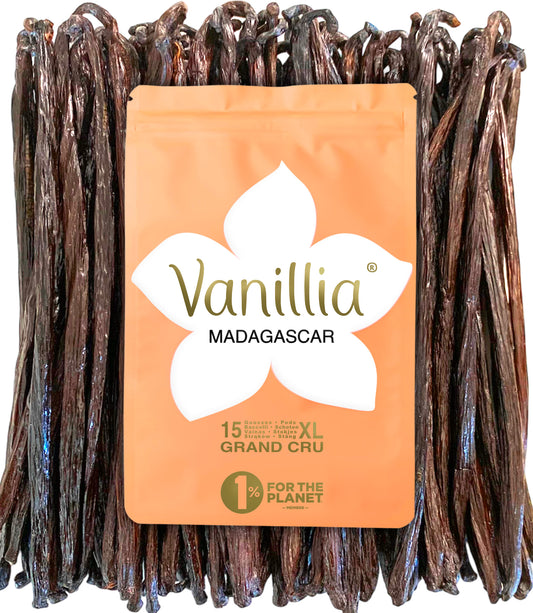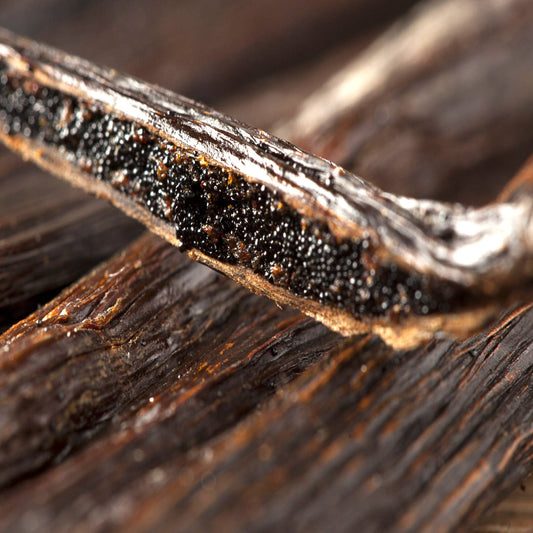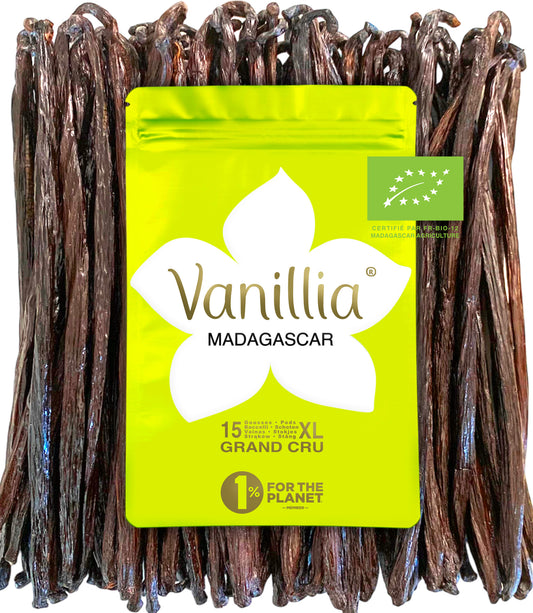
Vanilla Cultivation: The Secrets of Madagascar
Share
Discover Madagascar’s aromatic treasure: The culture of vanilla. Welcome to the enchanting world of Madagascar vanilla, an aromatic treasure that captivates fans of exquisite flavors. Renowned as some of the best in the world, Malagasy vanilla takes you on a unique sensory journey, and in this article, we invite you to explore all its secrets. Blending a tropical climate, rich soils, and traditional know-how, Madagascar offers the perfect conditions to grow the highest quality vanilla. From the delicate pollination of vanilla flowers to the slow, demanding ripening process, every stage of production is marked by rigorous artisanal methods that yield pods with exceptional aroma and intense flavor. Learn how Malagasy growers nurture and preserve this precious orchid, which requires patience, expertise, and respect for nature. You’ll also discover how Madagascar vanilla became a symbol of excellence in the culinary world, and how it’s used in countless sweet and savory recipes to delight food lovers. Immerse yourself in the fascinating world of vanilla cultivation in Madagascar and let yourself be enchanted by its captivating fragrance and divine taste.
Introduction
Welcome to the enchanting world of Malagasy vanilla, an aromatic treasure that makes the hearts of flavor enthusiasts beat faster. Renowned as one of the best in the world, Malagasy vanilla takes you on a unique sensory journey, and in this article, we invite you to discover all its secrets.
Combining a tropical climate, rich soils, and traditional know-how, Madagascar offers the ideal conditions for cultivating the highest quality vanilla. From the delicate hand-pollination of vanilla flowers to the slow and demanding maturation process, every step of production is marked by a rigorous artisanal process that yields beans with exceptional aroma and intense flavor.
Discover how Malagasy farmers care for and preserve this precious orchid, which requires patience, expertise, and respect for nature. You’ll also learn how Malagasy vanilla became a symbol of excellence in the culinary world, and how it’s used in a variety of sweet and savory recipes to delight food lovers everywhere.
Immerse yourself in the fascinating world of vanilla cultivation in Madagascar and let yourself be enchanted by its captivating fragrance and divine flavor.
What is vanilla cultivation in Madagascar?
Vanilla is an orchid native to Mexico, where it has been cultivated for centuries by Indigenous peoples. It was in the 19th century that vanilla was introduced to Madagascar—then a French colony—where it found ideal growing conditions and became one of the world’s largest producers.
Malagasy vanilla is renowned for its exceptional quality, thanks to a hot, humid tropical climate, nutrient-rich volcanic soils, and traditional know-how passed down from generation to generation. Vanilla plantations are mainly concentrated in the island’s northeast, in the Sava and Diana regions, where growing conditions are optimal.br/>
Grown using traditional methods, Malagasy vanilla undergoes a long and meticulous transformation process, starting with hand-pollination of the flowers and ending with careful drying and packaging. This demanding work, carried out with care and patience, gives Malagasy vanilla its unique aroma and incomparable flavor, making it one of the most renowned in the world.
The history of vanilla in Madagascar
The history of vanilla in Madagascar dates back to the 19th century, when this orchid was introduced to the island by French colonists. At that time, vanilla was already highly prized in Europe, but its cultivation was still mainly centered in its birthplace, Mexico.
It was in 1841 that the first Malagasy vanilla bean was exported to France, paving the way for a production that would only intensify over the decades. Thanks to ideal climate and soil conditions, vanilla quickly found its favorite terroir in the island’s northeast regions, especially in the Sava province.
For many years, Madagascar was the world’s leading vanilla supplier, accounting for up to 80% of global production. Even today, the island remains one of the top vanilla producers, with an estimated 60% market share. This leadership is due to the exceptional quality of Malagasy vanilla, renowned for its intense aroma and unique flavor.
The different varieties of Malagasy vanilla
Madagascar vanilla comes in several varieties, each with its own unique aromatic and flavor characteristics. The most famous and prized is Bourbon vanilla, also known as Planifolia vanilla or Madagascar vanilla.
This variety, originally from Mexico, was introduced to Madagascar in the 19th century and has adapted perfectly. It is distinguished by its long, slender, glossy black pods, which release notes of chocolate, caramel, and wood. Bourbon vanilla is the most widely grown in Madagascar and accounts for about 95% of production.
Besides Bourbon vanilla, there are also other less common varieties, such as Tahitensis vanilla, which is characterized by shorter, plumper beans with more floral and fruity notes. There’s also pompona vanilla, a rarer variety with even shorter and thicker beans, offering more powerful and spicy aromas.
Vanilla growing conditions in Madagascar
The success of Malagasy vanilla is largely due to the island’s exceptional growing conditions. Located in the Indian Ocean, Madagascar enjoys a hot and humid tropical climate, with average temperatures ranging from 68 to 86°F year-round.
The Sava and Diana regions in the northeast of the island are especially suitable for vanilla cultivation. They have nutrient-rich volcanic soils and high humidity thanks to abundant rainfall. These climatic and soil conditions, combined with the expertise of Malagasy growers, result in vanilla of exceptional quality.
In addition to the climate and soil, growing vanilla in Madagascar also requires significant shade, provided by the trees surrounding the plantations. This shade protects the vanilla vines from the sun’s intense rays and maintains a cool, humid environment, ideal for the plant’s development.
The vanilla cultivation process in Madagascar
Growing vanilla in Madagascar is a long, painstaking process that requires ancestral know-how passed down from generation to generation. Every step, from pollination to harvest, is carried out with the utmost care by Malagasy farmers.
It all starts with the manual pollination of vanilla flowers, a delicate process that must be done precisely. Each flower is fertilized individually, using a small stick, to ensure the formation of a quality vanilla bean.
Once pollination is complete, vanilla beans take several months to develop and ripen. This maturation phase is crucial, as it allows the vanilla’s aromas and flavors to fully emerge. Growers closely monitor the pods’ progress, protecting them from bad weather and predators.
The harvesting and processing of Malagasy vanilla
When the vanilla beans reach maturity, growers harvest them with great care. Each pod is picked individually, by hand, to avoid any damage.
Once harvested, vanilla beans undergo a lengthy transformation process that begins with steam blanching. This step sets the signature shiny black color of Malagasy vanilla and initiates the development of its aromas.
This is followed by drying, conditioning, and storage phases, all carried out with the utmost care to preserve the quality of the vanilla. This meticulous work, done with patience and expertise, gives Malagasy vanilla its unique aroma and incomparable flavor.
The economic importance of vanilla cultivation in Madagascar
Vanilla cultivation holds a central place in Madagascar’s economy, especially in the northeastern growing regions. This sector employs thousands of people, from farmers to exporters, and generates significant income for the country.
Madagascar is one of the world’s largest producers of vanilla, with an estimated 60% share of the market. This leading position is due to the exceptional quality of Malagasy vanilla, making it among the most sought-after and highly valued in the world. Vanilla exports represent a significant portion of Madagascar’s export revenue.
Beyond its direct economic impact, vanilla cultivation also plays a vital role in the sustainable development of rural communities in Madagascar. It generates stable income for farmers while preserving traditional expertise and a fragile ecosystem.
The challenges of the vanilla industry in Madagascar
Despite its position as a global leader, Madagascar’s vanilla industry faces several major challenges that threaten its sustainability. The first challenge is related to climate risks, with increasingly frequent droughts and cyclones that can severely impact harvests.
Another challenge is the fluctuation of global vanilla prices, which makes farmers' incomes very unstable. In fact, vanilla prices are extremely volatile and can double or halve from one year to the next. This economic instability weakens Malagasy producers and exposes them to significant risks.
Finally, the vanilla industry also faces competition from other producing countries, such as Indonesia or Mexico, which are striving to establish themselves in the global market. To stay competitive, Madagascar must continue to invest in the quality and traceability of its vanilla while diversifying its outlets.
Culinary and Medicinal Uses of Malagasy Vanilla
Malagasy vanilla is a prized ingredient in the culinary world, used in a multitude of sweet and savory recipes. Its notes of chocolate, caramel, and woodiness make it a top choice for desserts, ice cream, pastries, and sauces.
Beyond its culinary uses, Malagasy vanilla also has recognized medicinal benefits. Rich in antioxidant compounds, it is known for its anti-inflammatory and soothing properties. It is notably used in herbal medicine to treat digestive issues, headaches, and even sleep disorders.
Malagasy vanilla is also prized for its cosmetic benefits. Its essential oil is used in many beauty products—such as perfumes, creams, and lotions—for its soothing and skin-regenerating properties.
Conclusion: Malagasy vanilla, an aromatic treasure to discover
Malagasy vanilla is a true aromatic treasure, the result of ancestral expertise and an exceptional natural environment. From ideal climatic and soil conditions to artisanal cultivation and processing methods, every step of production helps make Malagasy vanilla among the most renowned in the world.
Whether in the kitchens of top chefs or in traditional medicine, Malagasy vanilla shines through its quality and wide range of uses. Its intense notes of chocolate, caramel, and woodiness make it a favorite ingredient among gourmets, while its medicinal properties make it a valuable ally for health and wellness.
So don’t wait any longer—set off to discover this aromatic Malagasy treasure and let yourself be captivated by its enchanting fragrance and divine flavor. From flower pollination to tasting its pods, you’ll experience a unique sensory journey in the heart of Madagascar.





